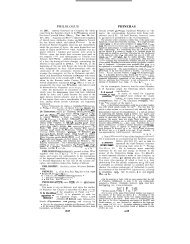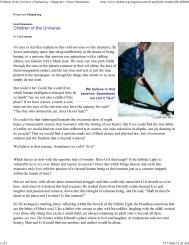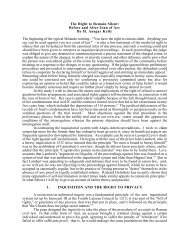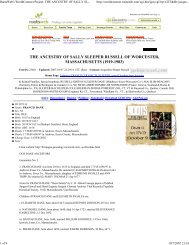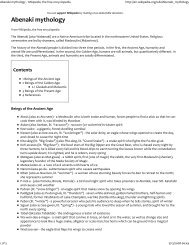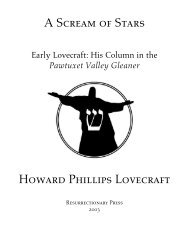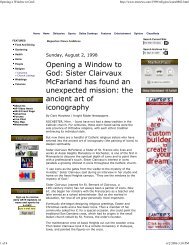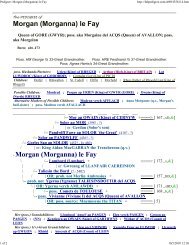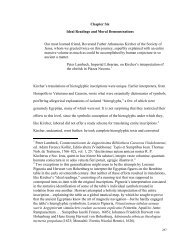Encylodaedia Biblica; a critical dictionary of the literary, political and ...
Encylodaedia Biblica; a critical dictionary of the literary, political and ...
Encylodaedia Biblica; a critical dictionary of the literary, political and ...
You also want an ePaper? Increase the reach of your titles
YUMPU automatically turns print PDFs into web optimized ePapers that Google loves.
ZINA<br />
9-21<br />
ZIPH<br />
[sou<strong>the</strong>rii] Arammites thresh [<strong>the</strong> sou<strong>the</strong>rn] Gilead with instruments<br />
<strong>of</strong> iron). Still <strong>the</strong> method <strong>of</strong> grouping names before<br />
seeking to account for <strong>the</strong>m seems to favour <strong>the</strong> preceding<br />
explanation. The euva[x] in @B <strong>and</strong> <strong>the</strong> Hh3 in Tg. Jer. are at<br />
any rate exceptional. T. K. C.<br />
ZINA (K?’!), b. Shimei, a Gershonite Levite (I Ch.<br />
23 IO). In u. II <strong>the</strong> name becomes ZIZAH (n]*)). @BAL reads<br />
&‘a in both places.<br />
ZION (I+?, C[E]IWN). The designation, properly,<br />
<strong>of</strong> <strong>the</strong> ‘ Jebusite ’ stronghold at Jerusalem, which<br />
after its capture by David received <strong>the</strong> name ‘ David‘s<br />
burg,’ 2 S. 57 9. Various explanations <strong>of</strong> <strong>the</strong> name<br />
have been given. Gesenius ( Thes. 1164) <strong>and</strong> Lagarde<br />
(Ubers. 84, n.”) derive from Jnnu ‘to be dry,’ cp<br />
, m<br />
Syr. \Q’~J, which Lag. regards as <strong>the</strong> older<br />
form. Delitzsch (P.dvzen,(3) 170) makes <strong>the</strong> primary<br />
form pi:, from a;! to set up.’ Wetzstein (in Del.<br />
Gen.(Y 578) derives from ,&I ‘to protect,’ so that <strong>the</strong><br />
name would mean ~YX, citadel ’ ; cp ZIN.<br />
It may be better, however, to add p’t to <strong>the</strong> group Zin, Zenan,<br />
Zaanan, <strong>and</strong> Zoan, <strong>and</strong> to suppose Zion to he a descendant <strong>of</strong><br />
:he race-name ‘ Ishmael’ through <strong>the</strong> intermediate form iiyx<br />
(ZIBEON). Ano<strong>the</strong>r corruption <strong>of</strong> <strong>the</strong> same name is probably &w<br />
(see SHALEM), <strong>and</strong> this most plausibly accounts for a muchdisputed<br />
name n5pi-p. That <strong>the</strong> first part <strong>of</strong> this name means<br />
‘ city,’ Sayce (see col. 2409, top) <strong>and</strong> Nestle (PhiloZoga Sacra,<br />
17) have independently seen. We must now add that o h is<br />
probably=5Nynp*, <strong>and</strong> that this is a type <strong>of</strong> corruption which<br />
occurs frequently in <strong>the</strong> OT. Jerusalem, <strong>the</strong>n, according to<br />
this explanation, was originally one <strong>of</strong> <strong>the</strong> many Ishmaelite or<br />
phmeelite settlements in Palestine, a view which is wpporte:<br />
y <strong>the</strong> fact that Isaiah (29 I) calls <strong>the</strong> city <strong>of</strong> David ‘ Jerahmeel<br />
[corrupted into ‘ Ariel ’I, <strong>and</strong> by <strong>the</strong> equally significant statement<br />
<strong>of</strong> <strong>the</strong> historian that after taking <strong>the</strong> stronghold David ‘built<br />
round about Jerahmeel <strong>and</strong> within.’l See Crit. Bi6. It is true,<br />
David is said (2 8.56) to have ‘gone against <strong>the</strong> Jebusites,’ hut<br />
<strong>the</strong> Jehusites apparently owe <strong>the</strong>ir existence in <strong>the</strong> text to<br />
corruption, <strong>and</strong> in an earlier form <strong>of</strong> <strong>the</strong> text this seems to have<br />
been indicated by <strong>the</strong> scribe himself. As in Gen. 30 zo [see<br />
ZIBEON] <strong>and</strong> elsewhere, <strong>the</strong> corrupt reading yyxn qp‘ (EV ‘<strong>the</strong><br />
inhabitants <strong>of</strong> <strong>the</strong> l<strong>and</strong> ’)has grown out <strong>of</strong> ’.inyap, (Ishmaelites),<br />
yi~a being an editor’s insertion to make <strong>the</strong> corrupt 33tp intelligible.<br />
The earlier text appears to have said in 3. 6, ‘And<br />
<strong>the</strong> king <strong>and</strong> his men went to Jerusalem against <strong>the</strong> fshmaelites’;<br />
‘ Ishmaelites’ here is a synonym <strong>of</strong> ‘ Jerahmeelites. To this we<br />
must add that <strong>the</strong> ‘lame’ <strong>and</strong> <strong>the</strong> ‘blind ’ spoken <strong>of</strong> in <strong>the</strong> MT<br />
(<strong>and</strong> in @) <strong>of</strong> 2 S 5 6 8 are as imaginary as <strong>the</strong> trihal name<br />
‘ Jebusite’ ; o’ny <strong>and</strong> o*n~3 both being corrupt fragments <strong>of</strong><br />
9 mn?‘ (see Crit. Ri6.. <strong>and</strong> cp MEPHIBOSHETH PHINEHAS).<br />
\‘his is no digression ; it had to he shown that &me, so closely<br />
connected as Zion <strong>and</strong> (Jeru-)salem had <strong>the</strong> same origin, <strong>and</strong> If<br />
in <strong>the</strong> course <strong>of</strong> doing so we have been enabled to show that <strong>the</strong><br />
early historians at any rate did not ‘infer incorrectly’ from <strong>the</strong><br />
trihal name Jebusite <strong>the</strong> existence <strong>of</strong> a city called Jebusz (<strong>of</strong><br />
which <strong>the</strong> Amarna correspondence appears to have known<br />
nothing), this is perhaps at any rate a boon for future students.<br />
It is possible that <strong>the</strong> error *013* for ’95Nynp- is really a somewhat<br />
ancient one (see, e.g., Zech. 9 7). But Ezekiel (lti 3 45) is<br />
still aware that Amorites (or Arammites- Jerahmeelites) <strong>and</strong><br />
Hittites (ra<strong>the</strong>r Rehobothites) formed <strong>the</strong> pre-Israelitish population<br />
<strong>of</strong> <strong>the</strong> city <strong>of</strong> Jeru:;alem. Cp OC.<br />
The term ‘Zion’ (we retain <strong>the</strong> term, as, even if a<br />
corruption, yet an ancient <strong>and</strong> a popular one) belongs<br />
properly, as shown elsewhere (JERUSALEM, 5s 17-20),<br />
to <strong>the</strong> sou<strong>the</strong>rn part <strong>of</strong> <strong>the</strong> eastern hill, where <strong>the</strong> ‘burg<br />
<strong>of</strong> David ‘ stood. Above <strong>the</strong> ‘ burg’ rose <strong>the</strong> temple,<br />
<strong>and</strong> in usage ‘Zion’ represents <strong>the</strong> temple hill (2 K.<br />
1931 ; Is. 2423 ; cp 1032). Even more commonly,<br />
however, we find it a term for <strong>the</strong> whole <strong>of</strong> Jerusalem,<br />
whe<strong>the</strong>r in parallelism with Jerusalem (Is. 43 3019<br />
Am. 12 hlic. 3x0 IZ Ps. 10222) or alone (Is. 127 2816<br />
Jer. 3 14 Lam. 5 11). Often it is personified (Is. 409 41 27<br />
51 3 52 I$ 7 59 20 60 14 668 Zeph. 3 16 Zech. 117) though<br />
here an idealisation has taken place, <strong>the</strong> ‘ Zion ’ intended<br />
being really <strong>the</strong> company <strong>of</strong> those residents in <strong>the</strong><br />
Holy City in <strong>the</strong> period <strong>of</strong> <strong>the</strong> Second Isaiah <strong>and</strong> <strong>of</strong><br />
Ezra who, in <strong>the</strong> orthodox sense <strong>of</strong> <strong>the</strong> phrase, ‘ feared<br />
Yahwk.’ The phrase ng, literally ‘ <strong>the</strong> daughter<br />
Zion,’ is an idiomatic expression for <strong>the</strong> people <strong>of</strong><br />
Jerusalem, Is. 18 522 Jer. 431, etc. (see DAUGHTER, 3).<br />
It remains to be added that ‘Zion,’ in I Macc.<br />
everywhere means <strong>the</strong> temple hill (see 437 60 554 64862<br />
733 1011 1427). For a Hebrew writer, who formed<br />
his style on classical models, this was natural. Josephus,<br />
writing in Greek, does not use <strong>the</strong> name. In <strong>the</strong> NT<br />
it occurs only in quotations from <strong>the</strong> OT, except in<br />
Heb. 1222 (a fine rhetorical passage) <strong>and</strong> in Rev. 141.<br />
How fond <strong>the</strong> later Jews became <strong>of</strong> <strong>the</strong> name Zion<br />
appears most clearly from <strong>the</strong> Psalms. See especially<br />
Ps. 875, if, with Wellhausen, we may follow 6’s &qp<br />
Z[~]C&V, gppei BvOpwrros), <strong>and</strong> render,<br />
But every one calls Zion his mo<strong>the</strong>r,<br />
And <strong>of</strong> it is every one native ;<br />
He himself, <strong>the</strong> Most High, keeps it.1<br />
T. K. C.<br />
ZIOR(7P’y; cwpe [B]. CwpAle [Babvid.; superscr.<br />
AI], clwp [AL]), a place in <strong>the</strong> hill-country <strong>of</strong> Judah<br />
(Josh. 1554t). It is mentioned with Arab, Bethtappuah,<br />
Humtah, Kirjath-nrba (‘ <strong>the</strong> same is Hebron’).<br />
The names Arab <strong>and</strong> Kirjatb-arba (surely from Kirjath-*arBb)<br />
point to <strong>the</strong> Jerahmeelite border. So also does Humtah (?.e.,<br />
Hamat$= Maacab) <strong>and</strong> perhaps Beth-tappuah (tee NAPHTU-<br />
HIM). Hebron’ in <strong>the</strong> gloss on ‘Kirjath-arba’ is probably (as<br />
in some o<strong>the</strong>r cases) a corruption <strong>of</strong> ‘ Rehoboth ’ ; P may already<br />
have found this corruption in <strong>the</strong> written list which he seems to<br />
have used. Zior,’ <strong>the</strong>n, is probably a corruption <strong>of</strong> <strong>the</strong> name<br />
<strong>of</strong> some Jerahmeelite place near Rehoboth. One cannot help<br />
thinking <strong>of</strong> Misgur, properly <strong>the</strong> name <strong>of</strong> a region (see hfIZKAIY,<br />
5 z6), but possibly also <strong>of</strong> a town (cp Cusham-jerahmeel<br />
[SHECHEM]). The reading <strong>of</strong> @AL may suggest an identification<br />
with ZAIR (p.~.).<br />
Van de Velde <strong>and</strong> Conder, however, identify Zior with Sa‘ir<br />
or (Pi7F.W 3 309) Si’air, 4$ m. N. from Hebron, where a tomb<br />
<strong>of</strong> Esau is shown. Eusehius (OS293 19) mentions a village Sior<br />
between Elia <strong>and</strong> Eleu<strong>the</strong>ropolis.<br />
T. IC. C.<br />
ZIPH (?’I; Z[E]I@ [BAL]), whence <strong>the</strong> gentilic<br />
Ziphites, or, incorrectly [see Ps. 541, Ziphims (D?i ;<br />
z[e]i@aiO~~ I s. 2319 261 Ps. 54 title ZI@EOYC TI).<br />
I. An unidentified town belonging to Judah, situated<br />
towards <strong>the</strong> border <strong>of</strong> Edom (Josh. 15 24 [? B]). On <strong>the</strong><br />
new <strong>the</strong>ory which makes David carve out for himself<br />
at first a principality in <strong>the</strong> Negeh, this more sou<strong>the</strong>rn<br />
Ziph may have a claim to be that intended in <strong>the</strong> early<br />
tradition. See 2. end.<br />
2. A town in <strong>the</strong> hill-country <strong>of</strong> Judah (Josh. 1555 ;<br />
<strong>of</strong>c@ [R]). mentioned toge<strong>the</strong>r with Maon, Carmel, <strong>and</strong><br />
Jutah. Its connection with <strong>the</strong> clan <strong>of</strong> Caleb, which at<br />
one time had its seat about Hebron (but see below), is<br />
expressed in genealogical form in I Ch. 24~,~ <strong>and</strong> again<br />
in I Ch. 4 16, where Ziph <strong>and</strong> Ziphah (a?’!; T! ; jzl41a<br />
KUL fu‘arpa [B], &@ai K. &$a [A], f~$ K.



